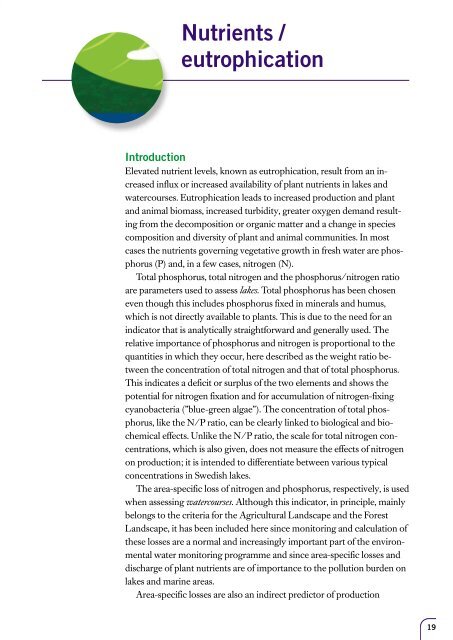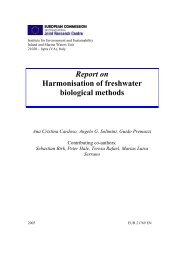Lakes and Watercourses
Lakes and Watercourses
Lakes and Watercourses
You also want an ePaper? Increase the reach of your titles
YUMPU automatically turns print PDFs into web optimized ePapers that Google loves.
Nutrients /<br />
eutrophication<br />
Introduction<br />
Elevated nutrient levels, known as eutrophication, result from an increased<br />
influx or increased availability of plant nutrients in lakes <strong>and</strong><br />
watercourses. Eutrophication leads to increased production <strong>and</strong> plant<br />
<strong>and</strong> animal biomass, increased turbidity, greater oxygen dem<strong>and</strong> resulting<br />
from the decomposition or organic matter <strong>and</strong> a change in species<br />
composition <strong>and</strong> diversity of plant <strong>and</strong> animal communities. In most<br />
cases the nutrients governing vegetative growth in fresh water are phosphorus<br />
(P) <strong>and</strong>, in a few cases, nitrogen (N).<br />
Total phosphorus, total nitrogen <strong>and</strong> the phosphorus/nitrogen ratio<br />
are parameters used to assess lakes. Total phosphorus has been chosen<br />
even though this includes phosphorus fixed in minerals <strong>and</strong> humus,<br />
which is not directly available to plants. This is due to the need for an<br />
indicator that is analytically straightforward <strong>and</strong> generally used. The<br />
relative importance of phosphorus <strong>and</strong> nitrogen is proportional to the<br />
quantities in which they occur, here described as the weight ratio between<br />
the concentration of total nitrogen <strong>and</strong> that of total phosphorus.<br />
This indicates a deficit or surplus of the two elements <strong>and</strong> shows the<br />
potential for nitrogen fixation <strong>and</strong> for accumulation of nitrogen-fixing<br />
cyanobacteria (”blue-green algae”). The concentration of total phosphorus,<br />
like the N/P ratio, can be clearly linked to biological <strong>and</strong> biochemical<br />
effects. Unlike the N/P ratio, the scale for total nitrogen concentrations,<br />
which is also given, does not measure the effects of nitrogen<br />
on production; it is intended to differentiate between various typical<br />
concentrations in Swedish lakes.<br />
The area-specific loss of nitrogen <strong>and</strong> phosphorus, respectively, is used<br />
when assessing watercourses. Although this indicator, in principle, mainly<br />
belongs to the criteria for the Agricultural L<strong>and</strong>scape <strong>and</strong> the Forest<br />
L<strong>and</strong>scape, it has been included here since monitoring <strong>and</strong> calculation of<br />
these losses are a normal <strong>and</strong> increasingly important part of the environmental<br />
water monitoring programme <strong>and</strong> since area-specific losses <strong>and</strong><br />
discharge of plant nutrients are of importance to the pollution burden on<br />
lakes <strong>and</strong> marine areas.<br />
Area-specific losses are also an indirect predictor of production<br />
19















![Accommodation booking form [PDF]](https://img.yumpu.com/39471785/1/184x260/accommodation-booking-form-pdf.jpg?quality=85)

